With thousands of companies exhibiting at CES, you see all sorts of things across a wide array of viability levels. Some stuff you see you’ll know will be a hit. While others it’s just a matter of time before not just the product, but the company folds.
But then there’s the stuff in between – the stuff that might have a future, but the pathway isn’t crystal clear. A perfect example of that is Spire. The company is at CES this week showing off their semi-permanent, semi-disposable biometric sensors that will monitor your heart rate, track steps, and do all the other glorious things that your average optical HR sensor watch will do…except, it doesn’t require a watch be worn.
I say ‘semi-permanent’ because it can be removed from clothing, but it’s not really designed to be. And I say ‘semi-disposable’ because it’s designed to last about 18 months, versus just being a one-time wonder. But once the battery dies, it’s throwaway.
The sensors are being sold in 3 packs ($99) and 8 packs ($199), with the thinking that you’d buy enough to outfit all of your undergarments for a week, allowing you constant tracking day and night (sans wearable). They plan to start shipping in March.
And technically, it doesn’t have to be your undergarments, in fact, they had a dedicated booth station to swim apparel as an example category. And that’s logical, the majority of competitive swimmers hate wearing watches in the pool – so something that’s sleek and unobtrusive would potentially work here. Assuming one cared about their metrics in the pool. But the same would/could apply to other areas like running shorts, cycling kits, etc…
The pod itself has a soft fabric on the side facing your body, which also has the optical HR sensor placed there as well to read your heart rate. The pod is machine washable, so you can let it go for a spin or forty in your washing machine without in theory killing it.
All of this data then transmits to their smartphone app using Bluetooth Smart. Heart rate data is semi-continuously monitored. So not quite every second, but frequent enough that it’s on par with most activity trackers doing updates every couple minutes. It doesn’t transmit out though as a standard Bluetooth Smart HR sensor, so you can’t quite just pair it up to an app/machine/etc. On the flip side, it does track heart rate variability.
In some ways, this reminds me of the sticker concept from three years ago at CES, Ampstrip. Unfortunately in that case, they quickly realized how much more money they’d make in the medical realm, and shifted direction away from consumers/sports (I can’t blame them). And in some ways, Spire may be plotting the same thing. In discussions with them, they are currently evaluating the path forward for FDA certification. That’s of course the Great Wall that divides consumer electronics like your Garmin or Fitbit, to official medical devices that usually cost a crapton more but are regulated and certified. That process is long and costly.
Circling back to the very beginning though – this is a product I’m a bit conflicted on. On one hand, the technology aspect of it appears impressive – and I think the idea in the right hands (and maybe slightly tweaked on price point) it could be a really fascinating way to get true 24×7 data for those that don’t want to wear a watch (24×7 or otherwise).
But the question is – are there enough people in that Venn diagram between those that want the data, but are unwilling to wear a watch to collect it? With optical HR sensors on watches becoming smaller and smaller, it’s no longer only bulky watches that have HR sensors built-in. Now, wafer thin lightweight watches have them too. So this really comes down to people who might not want to wear a watch at night.
Which ultimately makes me think that the best path forward for them is likely the medical realm, and likely following a buy-out by a bigger player.
Either way – I’d be curious to hear what you think. Is there a viable market for them, and if so – what’s the target use-case?
With that – thanks for reading!
FOUND THIS POST USEFUL? SUPPORT THE SITE!
Hopefully, you found this post useful. The website is really a labor of love, so please consider becoming a DC RAINMAKER Supporter. This gets you an ad-free experience, and access to our (mostly) bi-monthly behind-the-scenes video series of “Shed Talkin’”.
Support DCRainMaker - Shop on Amazon
Otherwise, perhaps consider using the below link if shopping on Amazon. As an Amazon Associate, I earn from qualifying purchases. It doesn’t cost you anything extra, but your purchases help support this website a lot. It could simply be buying toilet paper, or this pizza oven we use and love.

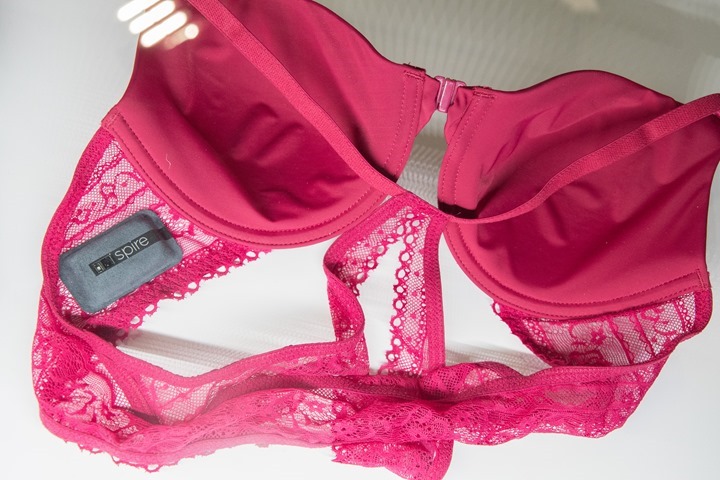
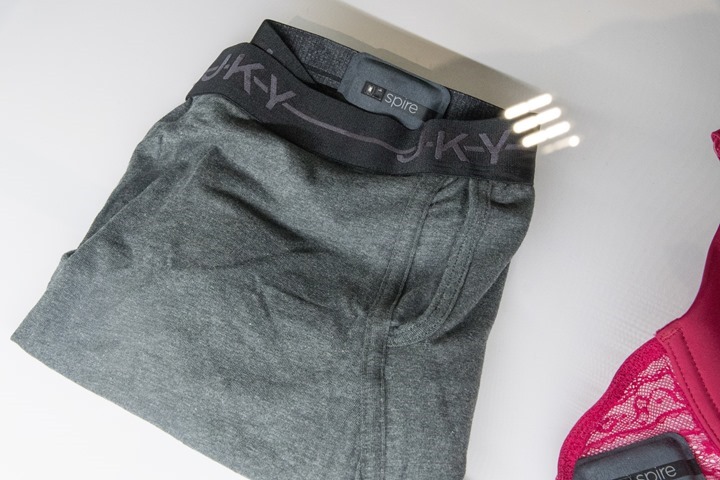
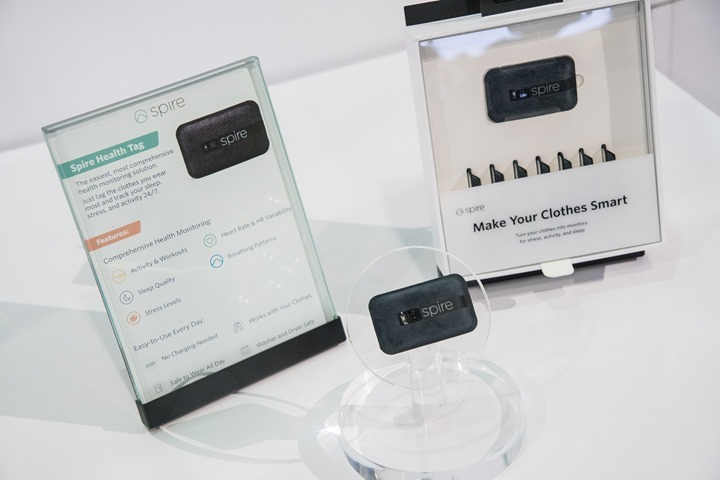
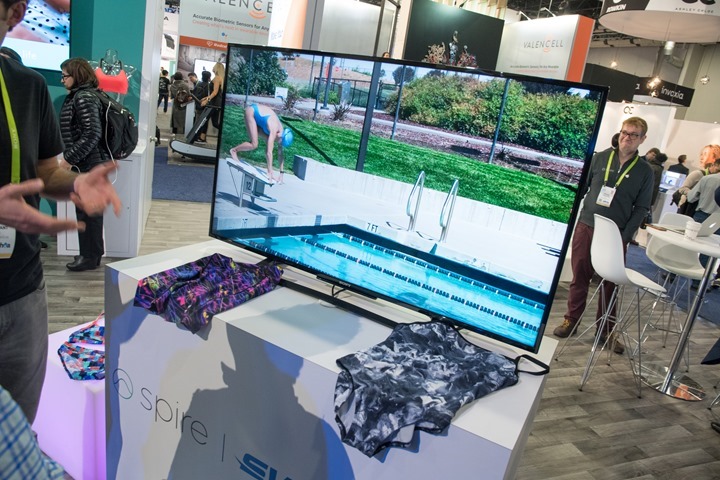
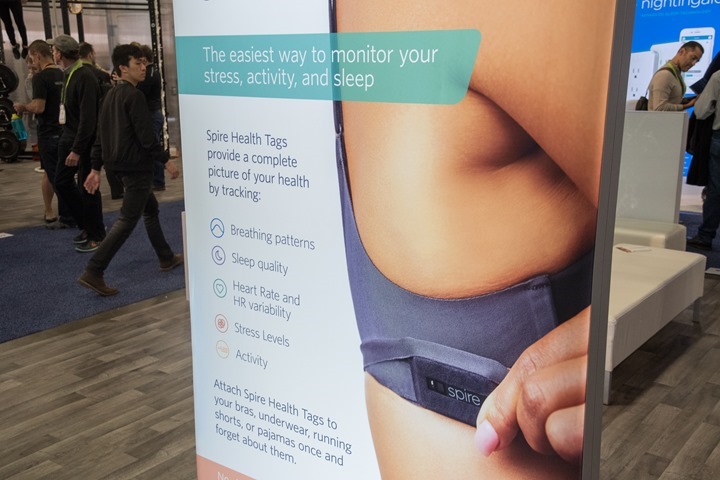
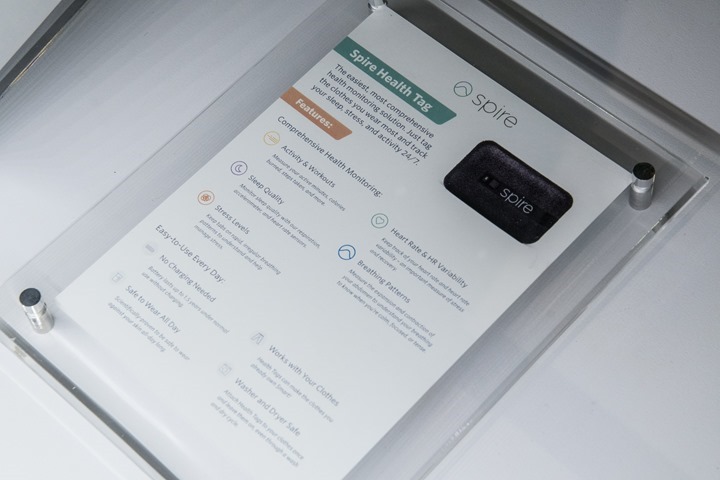
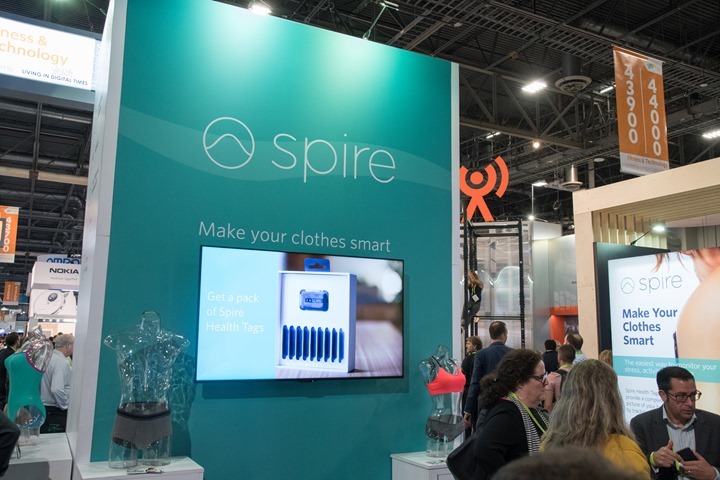



















I went to college with Neema (one of the co-founders), they’ve been doing breathing tracking for awhile now so been good at stress through that metric. This seems to be trying to add on heart rate
I wonder how well this will work for sports tracking (vs just 24/7). For heart rate, I would think that placement would be critical. They show it on the waist band, does anyone know if you can get accurate heart rate from around your belly? Also, most algorithms for evaluating movement need to have some idea where the accelerometer is located to get usable results. Seems kind of like a solution looking for a problem.
link to support.spire.io
For men, we recommend attaching Health Tags to the waistband of your underwear. For women, we recommend attaching Health Tags to the wing of your bra during the day, and to pajamas or underwear while you sleep.
So if ypu wore these on your butt would they be called “asspire”?
Throwaway electronics isn’t really ethical, especially in this day and age. At the very least It would be great to trade in the old ones for discounted new ones. A step up would be to support wireless charging.
I’d be pretty happy if most items went wireless. I’ve Qi in a few places to charge my phone. It would be great if I could also dump my watches / cycle comps / HRMs on them too. Instead of having a hundred USB to weird never the same twice propriety plug cables.
Company should offer recycling at no charge for shipping.
Tell them to stop designing ridiculous throwaway items. Put a battery compartment on those things. We’ll buy a new one when the old one breaks, we lose it, or we can’t stand not having a newer model, not when the battery is depleted because the company designed a stupid product. These blatant revenue-seeking business models should be banished by rational actors refusing to buy these products.
The reason companies do sealed batteries is simple: Waterproofing
When you start adding doors to replace batteries, your waterproofing (especially for something rated for washers and drying machines), evaporates.
I’m not seeing these being washed *in* the clothes. I guess that’s possible, but I’m not seeing it. Would a person have many redundant units, or would the owner switch between various items of clothing? I’m opposed for cost and environmental reasons. But doesn’t this also violate some EU directive for disposing, recycling, and removing batteries from items? (Directive 206/66 might apply. I found that in five minutes by searching online.)
The waterproofing issue is fair, but it is incredibly environmentally unsound to be coming out with this sort of throw-away electronic device nowadays when the entire civilized world (except for some of our leadership, but I’m going to leave that alone) is trying to move in the opposite direction, towards greater sustainability and lower environmental impact. Is the waterproofing on rechargeable devices as good? Probably not. Is the Earth going to be worse off with more throw-away tech? Absolutely.
I wish the company well in its future endeavors, but I hope this specific item stays niche/low volume and doesn’t take off.
-Ed
Yeah, I’m not a battery expert (specifically on costs or designs), but certainly Stryd does wireless charging with their sensor.
But it would take a legit battery expert (not just those of us who want to play one on the internet), to understand if that type of battery would be viable in this type of product without dramatic hits to battery life (or costs).
Not sure what activity they’d be tracking in the garment in the top picture…
Curious though, tracks respiration as well – so breathing rate? This could be super interesting for overnight tracking for sleep apnea.
Could you see whether it’s a red or green laser for the OHR? If they have capability for reflected pulse oximetry as well as heart rate, it could be another thing that gets a lot more traction in a medical application.
You are assuming people wear pyjamas or underwear at night, for 24 hr tracking. Not everyone does so that sweet spot in the Venn diagram may be even smaller.
As you point out I could see this as interesting for competitive swimmers. Chest straps and watches aren’t practical for 20+ hours a week in the pool. How much on-device storage is there? Could you just connect after at 3 hour workout and download stats? Could a coach be at the end of the lane with a tablet and check in on an athlete at random?
I am going to wait for something you can attach to your body, not wear. Think we’re less than 10 years away
Smarty Pants.
Well played sir, well played.
Ralph Lauren’s PoloTech Smart Shirt was introduced a few years ago and the rage was that it was too early to bring to market. The issues that it had were the fact that it only supported a iOS based app and for a price point of $295 USD the market wasn’t ripe to shell out the money for such technology.
I wear my scosche rhythm+ up on my arm just under the jersey sleeve as it is less distractive, and I forget it is there most of the time because it is comfortable. Wonder if this same concept can be integrated somewhere on a cyclying bib. Spending a lot of time on a bike seems like a valid usecase for an embedded monitoring.
My question would be CANCER…
I have the ATHOS shorts and shirt. Not really something you’d use for cycling (yet), but solid kit nonetheless: link to liveathos.com
Ray I bought my wife a Polar OH1 as she wanted something to track her HR when she exercises in the gym, but hates wearing a watch. So far it’s performed great (and is half the price of the cheapest watch with OHR here in South Africa). She’s not interested in wearing a tracker on her wrist, but when I showed her these she did seem interested as again it keeps her wrist free, so it would theoretically allow her to do 24 hour monitoring. So I agree that the market for this is small, but there definitely is a market.
was it really the most interesting gadget from a whole day of CES? hmm… sounds pretty boring…
It was the most interesting gadget that I could type up in 30 mins or less in between nonstop meetings.
I agree – this year CES was evolution not revolution in any of the sport-related equipment.
For me, here’s what I saw:
a) Hi-tech fabrics and discreet wearables for biometrics were the only real standouts in the space (as seen here)
b) Garmin’s ANT+ booth was interesting showing a bit more commitment toward making the standard better link sport and biometric data
c) Oddly Zwift/Kickr booth was unmanned during my floor walk
This is already being marketed to competitive swimmers- link to swimoutlet.com . Depending on the type and quality of metrics I would definitely be in. As much as I would like to have a record of the work completed, training with a watch is a big pain. I use my Vivoactive 3 (thinest, lightest available swim watch?) to check evenness of pace on long intervals after the fact, but beyond that it’s too annoying to start and stop on interval sets. On sets of 50s and 100s I just let it run through. Also, to use drill mode, you have to buy a huge, heavy, and expensive watch. To top it all off, the Vivoactive 3 misidentifies butterfly more than half of the time. For someone who trains for 100 and 200 butterfly, this is a big-time problem. I can certainly understand why serious swimmers don’t wear watches. If the Spire tag proves to be reasonable accurate and useful, then this masters swimmer will definitely give it a try!
There are plenty of people still preferring the Fitbit Zip because you can hide it under your clothes. But this is way too pricey for that group. And my sister is always misplacing her zip.
I like the idea…mostly. The flexibility of adding trackers to gym shorts, cycling kit, etc is a very clever idea and would have a lot of applications when wearing a tracker is not practical or ideal.
It’s the disposable nature of it that bugs me. Imagine if this caught on or if Fitbit/Garmin/Apple did this and sold hundreds of thousands of units that are getting thrown away every year and a half. There’s enough issues with e-waste as it is and a product that’s designed to be thrown away regularly seems like a step in the wrong direction.
Considering that many devices are going to wireless charging, it seems like a device like this would be better suited to that.
I’ve been using the Spire Stone, their earlier device for a year now. It doesn’t track HR but just activity and most importantly breathing cadence.
This is a safe buy based on their track record so far – the software and reporting side is important and the Spire has been working well.
For those complaining about the disposable nature of these tags, consider the Spire Stone, which has wireless recharging and can be clipped on to whatever clothes you wear. A good option for those who already using a watch with 24/7 OHR.
I like the fact they have an API to get your own data too.
Not having to wear a FASHION stupid so called ‘smart’ watch – or being able to get better metrics that work is interesting, to say the least. But I see this, especially with the breathing component crossed with heart rate, as an excellent way to gauge stress. So one eventual use case for this kind of tech is to share a daily summary with your spouse – this could be very helpful if one or both of the spouses had a particularly STRESSFUL day but didn’t realize it. Or to provide a warning to the other spouse. I’m probably revealing too much about my marriage but having a thirty minute head’s up that my spouse is going to come home ‘hot’ would help…a lot.
Oops, with this post dcrainmaker.com has become NSFW!
I have the habit of opening the site during my work meetings, and today it was not a good idea! ;-)
Just glad Ray didn’t model any action photos for this article.
There’s totally a market for that kind of stuff ! Activity trackers are still, design-wise, bulky in many ways. They are also silly gadgets that become obsolete or break every 12 to 18 months. Why would you want to show that off ? They also prevent you from wearing a real watch that might have a sentimental value. Products like the Spire would allow users to do something that’s completely revolutionary (or so pre-2014) : wear nothing on your wrist :) Now the problem is I don’t see this startup succeeding : the market is totally saturated and competing companies like Fitbit or Garmin are way too far ahead. I realize that every time and enter in a grocery store, tech store or sports store. Fitbit is retailed every-fucking-where and they’ve earned that over the many years of trying to establish a strong relationship with all those retailers. Unless Fitbit buys them…
Not a hope in hell.
So stick it to one pair of running shorts… great, they go in the wash, I now want to run again, but haven’t done the laundry….. Odds are the attachment would be buggered in a week, changing it from one garment to the next and or it will have become lost in the forgotten reaches of the wash bag.
The same would apply for swimmers, Even my old mum who is truly in the breaststroke and natter brigade has more than one swimming (her words not mine) cozzie. So again the same problem
If it somehow magically worked attached to a cycle helmet, or even a jacket that was likely to be used every time then… maybe… Otherwise It would have to be dirty cheap to be a one hit wonder for racing which I suspect won’t net them enough
That’s why the units are sold in 3/8/16 packs, it’s specifically designed not be swapped between clothes.
If it’s accurate I would definitely try it for sleep metrics. I wear an Apple Watch all day and a Garmin for running, but just can’t bring myself to sleep with either of them, plus it bugs my husband :)
Tried Beddit for sleep, but wasn’t too impressed. So yeah, sounds interesting.
Well, they certainly don’t understand half of their market – putting something in the band of the bra is asking for trouble, especially when it comes to well fitted bras and sports in general. The band should be tight. For someone who wears well fitted bras, there is very little space in the band, in any case not enough to fit a gizmo like this and for it to be comfortable.
I very much dislike the short life of this gadget, and if a charge can last year and a half, see if you can add wireless charging and multiply that!
Regarding placing in clothing, I would almost prefer a dock that you sew on and the unit itself can detach for laundry.
There are markets for this type of thing – not sure how large, but there are.
My girlfriend is a nurse and due to the issues of her job around scrubbing before procedures, she finds it impossible to wear a watch / fitbit due to contamination concerns. This could fit that segment of users with similar issues. I personally don’t agree with the throwaway aspect, but hopefully this is just their 1st gen approach and they will improve the devices to be rechargeable or at least recyclable.
Personally I think it’s a good idea to place something in a sports bra, rather than (as many of us do today) having a heart rate strap (like the Tickr) underneath the band of a tight fitting sports bra. Should be more comfortable, at the evry least. But I would like to see that something being detachable, and having the possibility to swap batteries (again like the Tickr).
I’ve used these now for a week or so to measure my breathing. It’s not reliable at all. The number of breaths per minute is very often way too high. Only when I lay on my back it seems accurate. When walking/sitting/standing it’s not accurate at all. I’ve tried the spire stone before, this had the same problem.
We all know how important it is to breathe right during exercise or sleep or work. So I am waiting for an improved version.